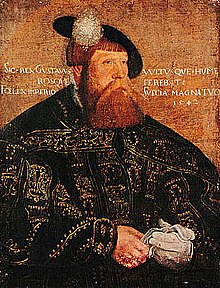Gustav Vasa
| Gustav I | |
|---|---|

Gustav I portrayed in 1542 by Jakob Bincks.
|
|
| King of Sweden | |
| Reign | 6 June 1523 – 29 September 1560 |
| Coronation | 6 June 1523 |
| Predecessor | Christian II |
| Successor | Eric XIV |
| Born |
12 May 1496 Rydboholm Castle, Uppland or Lindholmen, Uppland, Sweden |
| Died | 29 September 1560 (aged 64) Tre Kronor, , Sweden |
| Burial | 21 December 1560 Uppsala Cathedral, Uppsala, Sweden |
| Spouse |
Catherine of Saxe-Lauenburg Margaret Leijonhufvud Katarina Stenbock |
| Issue |
Eric XIV of Sweden John III of Sweden Katharina Vasa Cecilia, Margravine of Baden-Rodemachern Magnus, Duke of Östergötland Anna Maria, Countess Palatine of Veldenz Sophia, Duchess of Saxe-Lauenburg Elizabeth, Duchess of Mecklenburg-Gadebusch Charles IX of Sweden |
| House | Vasa |
| Father | Erik Johansson Vasa |
| Mother | Cecilia Månsdotter Eka |
| Religion |
Lutheran prev. Roman Catholic |
Gustav I, born Gustav Eriksson of the Vasa noble family and later known as Gustav Vasa (12 May 1496 – 29 September 1560), was King of Sweden from 1523 until his death in 1560, previously self-recognised Protector of the Realm (Riksföreståndare) from 1521, during the ongoing Swedish War of Liberation against King Christian II of Denmark, Norway and Sweden. Initially of low standing, Gustav rose to lead the rebel movement following the , in which his father perished. Gustav's election as King on 6 June 1523 and his triumphant eleven days later meant the end of Medieval Sweden's elective monarchy and the Kalmar Union, and the birth of a hereditary monarchy under the House of Vasa and its successors, including the current House of Bernadotte.
As King, Gustav proved an enigmatic administrator with a ruthless streak not inferior to his predecessor's, brutally suppressing subsequent uprisings (three in Dalarna – which had once been the first region to support his claim to the throne - one in Västergötland, and one in Småland). He worked to raise taxes, end Feudalism and bring about a Swedish Reformation, replacing the prerogatives of local landowners, noblemen and clergy with centrally appointed governors and bishops. His 37-year rule, which was the longest of a mature Swedish king to that date (subsequently passed by Gustav V and Carl XVI Gustav) saw a complete break with not only the Danish supremacy but also the Roman Catholic Church, whose assets were nationalised, with the Lutheran Church of Sweden established under his personal control. He became the first truly native Swedish sovereign and was a skilled propagandist and bureaucrat, with his main opponent, Christian's, infamous mark as the "tyrant king" and his largely fictitious adventures during the liberation struggle still widespread to date. Due to a vibrant dynastic succession, his three sons, Erik, Johan and Karl IX, all held the kingship at different points.
...
Wikipedia
